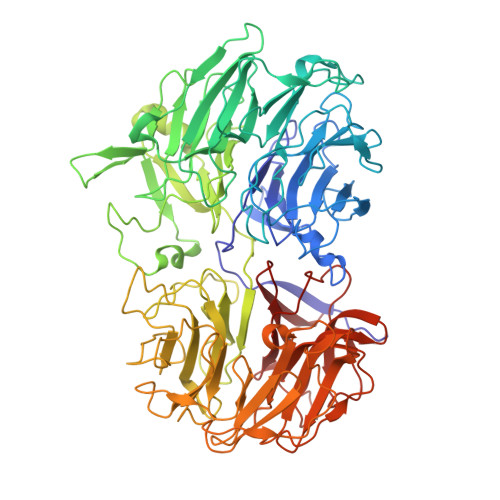Structural enzymology reveals the molecular basis of substrate regiospecificity and processivity of an exemplar bacterial glycoside hydrolase family 74endo-xyloglucanase.
Arnal, G., Stogios, P.J., Asohan, J., Skarina, T., Savchenko, A., Brumer, H.(2018) Biochem J 475: 3963-3978
- PubMed: 30463871
- DOI: https://doi.org/10.1042/BCJ20180763
- Primary Citation of Related Structures:
6MGJ, 6MGK, 6MGL - PubMed Abstract:
Paenibacillus odorifer produces a single multimodular enzyme containing a glycoside hydrolase (GH) family 74 module (AIQ73809). Recombinant production and characterization of the GH74 module ( Po GH74 cat ) revealed a highly specific, processive endo -xyloglucanase that can hydrolyze the polysaccharide backbone at both branched and unbranched positions. X-ray crystal structures obtained for the free enzyme and oligosaccharide complexes evidenced an extensive hydrophobic binding platform - the first in GH74 extending from subsites -4 to +6 - and unique mobile active-site loops. Site-directed mutagenesis revealed that glycine-476 was uniquely responsible for the promiscuous backbone-cleaving activity of Po GH74 cat ; replacement with tyrosine, which is conserved in many GH74 members, resulted in exclusive hydrolysis at unbranched glucose units. Likewise, systematic replacement of the hydrophobic platform residues constituting the positive subsites indicated their relative contributions to the processive mode of action. Specifically, W347 (+3 subsite) and W348 (+5 subsite) are essential for processivity, while W406 (+2 subsite) and Y372 (+6 subsite) are not strictly essential, but aid processivity.
Organizational Affiliation:
Michael Smith Laboratories, University of British Columbia, 2185 East Mall, Vancouver, BC V6T 1Z4, Canada.




















